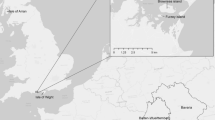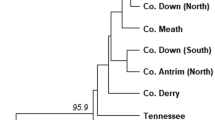Abstract
The two species of flying squirrels found in North America are the northern (Glaucomys sabrinus) and the southern (G. volans) flying squirrel. Both species have wide range distributions across North America, yet differences in their preferred habitat result in few areas of sympatry. Climate change however, has shifted the southern flying squirrel’s range limit further north, thus allowing the two species to encounter each other more frequently. Glaucomys volans is the more competitive of the two, and also carries a nematode parasite (Strongyloides robustus) proven to be deleterious towards its sister species. The northern incursion of the southern flying squirrel may therefore dislodge its sister species from its original distribution. With G. sabrinus considered endangered in different parts of North America, and G. volans listed as “concerned” in its northernmost limit, the two species require close monitoring. Morphological identification is often challenging for incomplete and juvenile specimens, therefore we developed a molecular identification protocol using mitochondrial and nuclear markers in tandem to help distinguish each species. These protocols were tested on Glaucomys individuals located elsewhere in Canada and the USA to ensure the validity of the designed primers. Moreover, employing our methods may detect F1 hybrids. To assess the current genetic portrait of G. sabrinus populations in Québec before the potential invasion of its sister species, a preliminary population genetics study using seven microsatellite loci was also realized. The various conservation and management implications are discussed.



Similar content being viewed by others
References
Allendorf FW, Leary RF, Spruell P, Wenburg JK (2001) The problems with hybrids: setting conservation guidelines. Trends Ecol Evol 16:613–622
Arbogast BS (1999) Mitochondrial DNA phylogeography of the new World flying squirrels (Glaucomys). J Mammal 80:142–155
Arbogast BS (2007) A brief history of the new world flying squirrels: phylogeny, biogeography and conservation genetics. J Mammal 88:840–849
Arbogast BS, Browne RA, Weigl PD, Kenagy GJ (2005) Conservation genetics of endangered flying squirrels (Glaucomys) from the Appalachian mountains of eastern North America. Anim Conserv 8:123–133
Bishop KL, Brim-Deforest W (2008) Kinematics of turning manoeuvres in the southern flying squirrel, Glaucomys volans. J Exp Zool 309A:225–242
Bowman J, Holloway GL, Malcolm JR, Middel KR, Wilson PJ (2005) Northern range boundary dynamics of southern flying squirrels: evidence of an energetic bottleneck. Can J Zool 83:1486–1494
Burt WH (1960) Bacula of North American mammals. Publications museum of zoology, vol 113. University of Michigan, Ann Arbor, pp 1–108
Dolan PG, Carter DC (1977) Glaucomys volans. Mamm Species 78:1–6
Evanno G, Regnaut S, Goudet J (2005) Detecting the number of clusters of individuals using the software STRUCTURE: a simulation study. Mol Ecol 14:2611–2620
Excoffier L, Lischer HE (2010) Arlequin suite version 3.5: a new series of programs to perform population genetics analyses under Linux and Windows. Mol Ecol Resour 10:564–567
Feldhamer GA, Drickamer LC, Vessey SH, Merritt JF (2004) Mammalogy: adaptation, diversity, and ecology, 2nd edn. McGraw-Hill, New York
Fokidis HB, Schable NA, Hagen C, Glenn C, Risch TS (2013) Characterization of microsatellite DNA loci for the southern flying squirrel (Glaucomys volans). Mol Ecol Notes 3:616–618
Garroway CJ, Bowman J, Cascaden TJ, Holloway GL, Mahan CG, Malcolm JR, Steele MA, Turner G, Wilson PJ (2010) Climate change induced hybridization in flying squirrels. Glob Change Biol 16:113–121
Garroway CJ, Bowman J, Holloway GL, Malcolm JR, Wilson PJ (2011) The genetic signature of rapid range expansion by flying squirrels in response to contemporary climate warming. Glob Change Biol 17:1760–1769
Holloway GL, Smith WP, Halpern CB, Gitzen RA, Maguire CC, West SD (2012) Influence of forest structure and experimental green-tree retention on northern flying squirrel (Glaucomys sabrinus) abundance. For Ecol Manag 285:187–194
Kerhoulas NJ, Arbogast BS (2010) Molecular systematics and Pleistocene biogeography of Mesoamerican flying squirrels. J Mammal 91:654–667
Lazure L, Paré P, Tessier N, Bourgault P, Dubois G, Canac-Marquis P, Lapointe F-J (in press) Known range expansion and morphological variation of southern flying squirrels (Glaucomys volans) in Québec. Canadian Field Naturalist.
Manning T, Hagar JC, McComb BC (2012) Thinning of young Douglas-fir forests decreases density of northern flying squirrels in the Oregon Cascades. For Ecol Manag 264:115–124
Martien K, Givens G, Archer E (2007) A note on the ability of STRUCTURE to correctly infer the number of populations for Bering–Chukchi–Beaufort Seas bowhead whales. In: Report SC/59/BRG34 presented to the Scientific Committee of the International Whaling Commission, Cambridge, pp 1–8
Muul I (1968) Behavioural and physiological influences on the distribution of the flying squirrel, Glaucomys volans. Publications museum of zoology, vol 134. University of Michigan, Ann Arbor, pp 1–76
Myers P, Lundrigan BL, Hoffman SMG, Haraminca AP, Seto SH (2009) Climate-induced changes in the small mammal communities of the Northern Great Lakes Region. Glob Change Biol 15:1434–1454
Olsen JB, Wenburg JK, Bentzen P (1996) Semi-automated multilocus genotyping of Pacific Salmon (Oncorhynchus spp.) using microsatellites. Mol Mar Biol Biotechnol 5:259–272
Patton JL, Da Silva MNF, Malcolm JR (2000) Mammals of the Rio Jurua and the evolutionary and ecological diversification of Amazonia. Bull Am Mus Nat Hist 244:1–306
Price PW, Westoby M, Rice B (1988) Parasite-mediated competition: some predictions and tests. Am Nat 131:544–555
Pritchard JK, Stephens M, Donnelly P (2000) Inference of population structure using multilocus genotype data. Genetics 155:945–959
Pritchard JK, Wen X, Falush D (2010) Documentation for structure software: Version 2.3. http://pritch.bsd.uchicago.edu/structure.html
Raymond M, Rousset F (1995) GENEPOP (version 1.2): population genetics software for exact test and ecumenism. J Hered 86:248–249
Rhymer JM, Simberloff D (1996) Extinction by hybridization and introgression. Annu Rev Ecol Evol Syst 27:83–109
Rowe JS (1972) Les régions forestières du Canada. Ministère de l’Environnement, Service canadien des forêts. Publication n° 1300F, p 177
Siegel SJ, Percopo CM, Dyer KD, Zhao W, Roth VL, Mercer JM, Rosenberg HF (2009) RNase 1 genes from the family Sciuridae define a novel rodent ribonuclease cluster. Mamm Genome 20:749–757
Smith WP (2012) Sentinels of ecological processes: the case of the northern flying squirrel. BioScience 62:950–961
Tessier N, Paré P, Rogic A, Canac-Marquis P, Lapointe F-J (2013) Acquisition de connaissance sur la répartition du grand polatouche (Glaucomys sabrinus) et petit polatouche (G. volans) au Québec. Université de Montréal, Département de sciences biologiques. MDDEFP rapport, Montréal, Québec. p 33
Thompson JD, Gibson TJ, Plewniak F, Jeanmougin F, Higgins DG (1997) The ClustalX windows interface: flexible strategies for multiple sequence alignment aided by quality analysis tools. Nucleic Acids Res 25:4876–4882
Thorington RW, Hoffman RS (2005) Family Sciuridae. In: Wilson DE, Reeder DM (eds) Mammal species of the world: a taxonomic and geographic reference, vol 2, 3rd edn. John Hopkins University Press, Baltimore, pp 745–818
Thorington RW, Musante AL, Anderson CG, Darrow K (1996) Validity of three genera of flying squirrels: eoglaucomys, Glaucomys and Hylopetes. J Mammal 77:69–83
U.S. Fish and Wildlife Service (2012) Endangered and threatened wildlife and plants: 90-day finding on a petition to list the Prince of Wales flying squirrel as threatened or endangered. Department of the Interior, Federal Registar, vol 77, pp 52301–52308
U.S. Fish and Wildlife Service (2013) Carolina northern flying squirrel (Glaucomys sabrinus coloratus) 5-year review: summary and evaluation. Southeast Region, Asheville Ecological Services Field Office
Weigl PD (1978) Resource overlap, interspecific interactions and the distribution of flying squirrels. Am Midl Nat 100:83–96
Weigl PD (2007) The northern flying squirrel (Glaucomys sabrinus): a conservation challenge. J Mammal 88:897–907
Wells-Gosling N (1982) Distribution of flying squirrels (Glaucomys) in Michigan. Mich Acad 143:209–216
Wells-Gosling N, Heaney LR (1984) Glaucomys sabrinus. Mamm Species 229:1–8
Wetzel EJ, Weigl PD (1994) Ecological implications for flying squirrels (Glaucomys spp.) of effects of temperature on the in vitro development and behaviour of Strongyloides robustus. Am Midl Nat 131:43–54
Wu S, Wu W, Zhang F, Ye J, Ni X, Sun J, Edwards SV, Meng J, Organ CL (2012) Molecular and paleontological evidence for a post-cretaceous origin of rodents. PLoS One 7:1–11
Zittlau KA, Davis CS, Strobeck C (2000) Characterization of microsatellite loci in northern flying squirrels (Glaucomys sabrinus). Mol Ecol 9:826–827
Acknowledgments
We would like to thank the trappers that participated in this study, including G. Bélanger, L. Binette, S. Brisebois, Y. Charlebois, P. Y. Collin, M. Dussault, M. Fiola, P. Fournier, M. Francoeur, C. Grenier, S. Guimont, J. Hardy, M. Hardy, Y, Jetté, Dé Miron, S. Paquette, J.-P. Rioux, Y. Rudacovitch, G. Tremblay, L. Tremblay, J.-P. Trudeau, and T. Turcotte. We would also like to thank Cindy Bouchard for lab work, Lucie Veilleux from the MRNF for producing the maps, and Julie Hébert for carrying out the morphometric measurements.
Author information
Authors and Affiliations
Corresponding author
Ethics declarations
Conflict of interest
The authors have no conflicts of interest to declare.
Appendix
Appendix
Microsatellite loci characterization
See Table 5.
Rights and permissions
About this article
Cite this article
Rogic, A., Dubois, G., Tessier, N. et al. Applying genetic methods to identify northern and southern flying squirrels and determine conservation needs. Conservation Genet Resour 8, 471–480 (2016). https://doi.org/10.1007/s12686-016-0569-0
Received:
Accepted:
Published:
Issue Date:
DOI: https://doi.org/10.1007/s12686-016-0569-0




